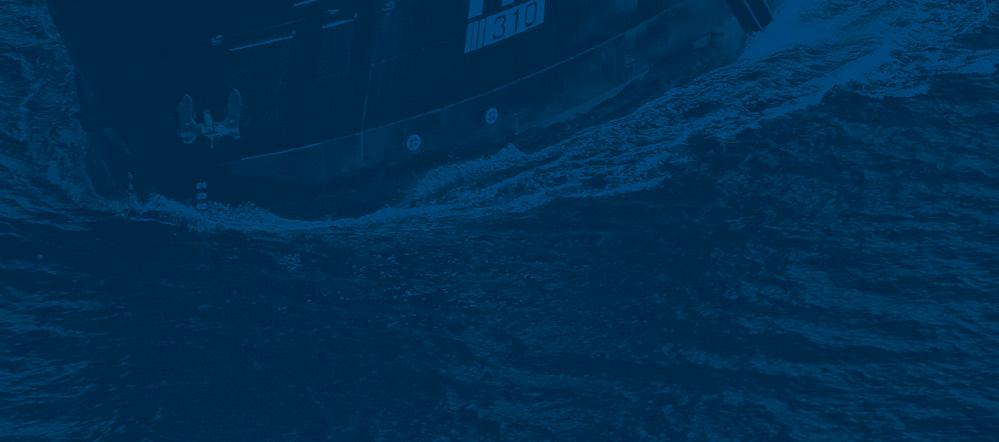
22 minute read
Around the Coast
AROUND THE COASTS NEWS FOR THE NATION’S FISHERMEN
The Department of Commerce and NOAA are seeking recommendations for a new national seafood trade strategy.
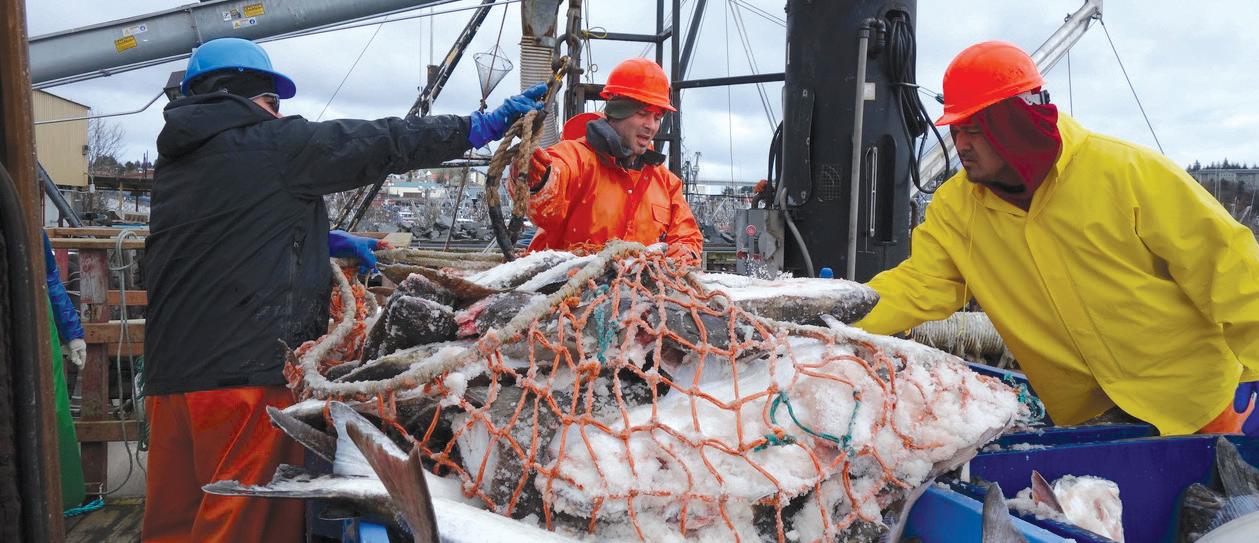

Nation / World
“The agency will work closely with interagency partners to develop a comprehensive interagency seafood trade strategy.” — Chris Oliver, NMFS
Washington gears up for new U.S. seafood trade policy
Call goes out to fi shermen and seafood industry to document overseas barriers
Afederal Interagency Seafood Trade markets through trade policy and negoTask Force now organizing at the Detiations; resolve technical barriers to U.S. partment of Commerce is seeking recomseafood exports; and otherwise support fair mendations for a new seafood trade policy market access for U.S. seafood products.” called for in President Trump’s May 7 exThe order aims to expand sustainable ecutive order. U.S. seafood production with “more e -
In a July 10 notice in the Federal Regcient and predictable aquaculture permitister, NOAA o cials asked for written adting” and research and development e orts, vice “from interested parties on how best to according to NOAA o cials. They also achieve the objectives of the Seafood Trade foresee “regulatory reform to maximize Task Force as described in the executive orcommercial shing,” and enforcing food der. NOAA Assistant Administrator Chris safety and quality requirements on seafood Oliver has said “the strategy will identify imports that do not meet U.S. standards. opportunities to improve access to foreign There is plenty in the order that sounds good to the U.S. industry, from New England ground sh eets cha ng under years of restrictions, the Gulf of Mexico shrimpers undercut by years of low-priced and lowerquality imports.
The new survey sought for the seafood task force looks for direction on pursuing the overarching trade strategy.
Among questions for seafood businesses, the agency is asking for speci c details on what kind of seafood products they are exporting and to what countries, along with how they hope to nd more customers in other nations.
“Are there issues in the markets that you currently export to that limit your exports, or unnecessarily increase the costs for your exports?” the notice asks.
The agency likewise asks for speci c examples of barriers and “issues that a ect the competitiveness of your product in foreign markets.” NOAA looked to have those answers in hand by Aug. 1. — Kirk Moore
First offshore wind towers for Virginia power project
Debate grows on turbine spacing
Dominion Energy and o shore wind developer Ørsted installed the rst two wind turbines on a federal lease in late June, a milestone in what backers hope is a rst step toward arrays o Virginia producing up to 2.6 gigawatts of power.
The 459-foot wind turbine installation vessel Vole au Vent raised the rst turbine to its tower June 20. The Coastal Virginia O shore Wind pilot project could be operational and producing electricity for the company’s grid in late summer or early fall, said G.T. Hollet, director of generation projects for Dominion.
Dominion plans the pilot program as a precursor to three phases for a utility-scale wind project on its federal lease, using much larger 14-MW Gamesa wind turbines, to be online in 2026. The fate of those plans and other wind energy leases o the East Coast hinges on ndings from the Bureau of Ocean Energy Management, in its ongoing environmental analysis of the 800-MW Vineyard Wind project in southern New England waters.
In a series of ve online public hearings, wind power advocates urged BOEM to accept a proposed 1 nautical mile grid layout for turbines as proposed by Vineyard Wind and other New England developers. That concept was endorsed by a Coast Guard marine tra c study, which recommended against designated four-mile-wide transit lanes sought by shing advocates of the Responsible O shore Development Alliance.
Requiring the transit lanes “will substantially reduce the area available for development without substantially improving the safety of navigation,” said Abby Watson, head of government a airs for turbine manufacturer Siemens Gamesa North America.
RODA came back with its own formal challenge, telling the Coast Guard its Massachusetts and Rhode Island Port Access Route Study “contains serious foundational
A Coast Guard port access study recommended against four-mile-wide transit lanes in wind turbine arrays.
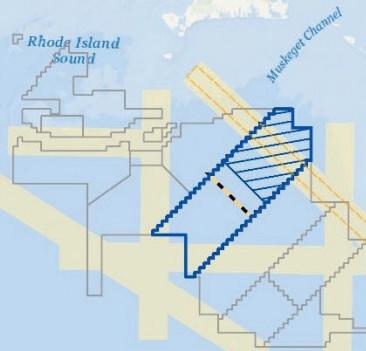

and analytical errors that merit correction” because they will inform BOEM’s future decision-making on such projects.
Among other shortcomings, the Coast Guard analysis relied heavily on Automatic Identi cation System vessel tracks to assess maritime tra c around the Vineyard Wind site — despite cautions from the shing industry and other sources that commercial shing vessels rarely use AIS, the RODA paper says. — Kirk Moore
DURAMAX MARINE ® TECHNOLOGY




Engineered To Work As Hard As You Do.
DryMax ® Maintenance Free Shaft Seal System
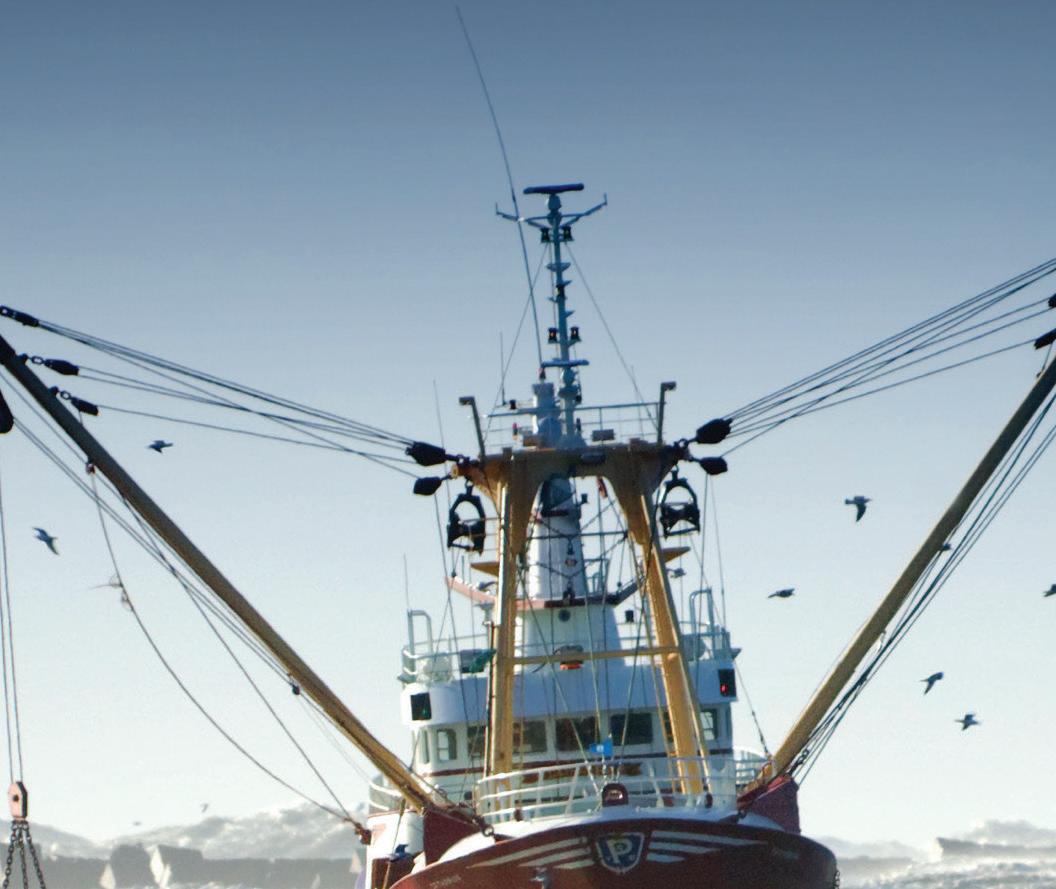
The Original Johnson ® Cutless ® Sleeve and Flange Bearings
DuraBlue ® Composite Rudder Bushings, Thrust Washers & Wear Plates Custom Engineered Heat Exchange Systems
Duramax Marine ® is an ISO 9001:2015 Certified Company

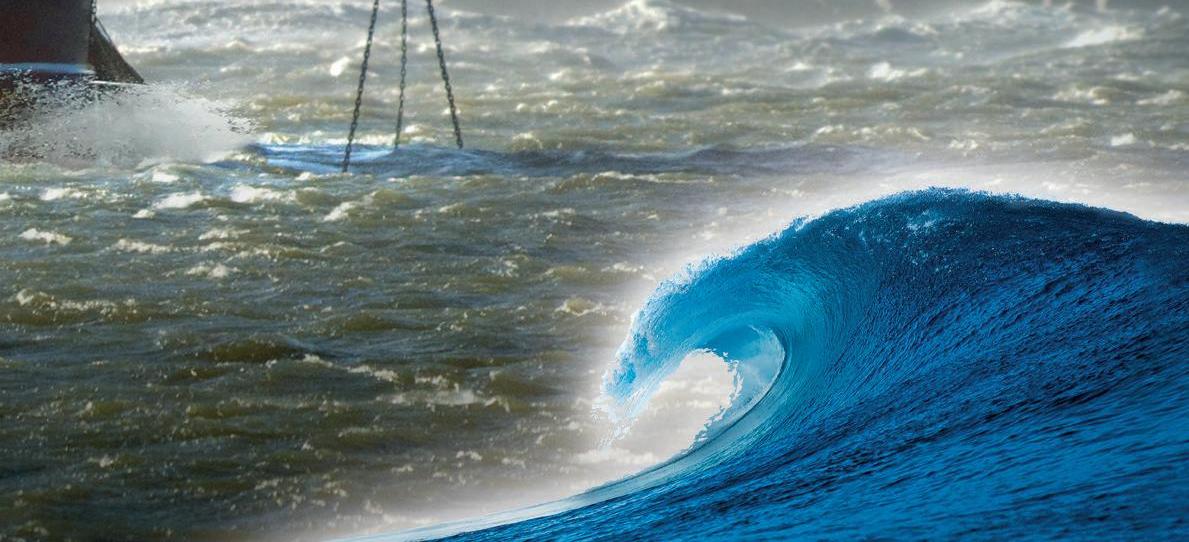




Alaska / Pacifi c
“Pebble Mine is a threat to Alaskan jobs, America’s food security, and a salmon resource unparalleled anywhere on the planet.” — Andy Wink, BBRSDA
Sockeye season in swing — with Pebble decision looming
Late salmon return seen with early Bristol Bay landings; awaiting mine decision

Setnet Selfi e: This Bristol Bay Ugashik crew set up a GoPro for pics between picks.
Working amid restrictions and fears and economic chaos caused by covid-19, Alaska shermen waited to learn if the development of a massive gold and copper mine that’s been hanging over their heads for two decades will get a greenlight from the federal government.
The U.S. Army Corps of Engineers
Charlie Ess

was expected to unveil its decision on the permit application by Northern Dynasty of Vancouver, Canada, to build the Pebble Mine at the sprawling mosaic of headwaters that provide the spawning and rearing grounds for the region’s salmon.
Three decisions are possible for the mine: issue a permit, issue a permit with conditions, or deny the application.
“As Bristol Bay’s shermen head out to the shing grounds for the next six weeks, we are counting on Congress to protect the 14,500 workers directly employed by the commercial salmon shery,” said Andy Wink, executive director of the Bristol Bay Regional Seafood Development Association. “Pebble Mine is a threat to Alaskan jobs, America’s food security, and a salmon resource unparalleled anywhere on the planet.”
Such calls for help appeared to go unheard by Alaska’s political leaders. The state’s two Republican senators and lone representative have staunchly stood behind the Pebble project’s right to go through a rigorous and fair permitting process and remained tightlipped about their opinions in the meantime.
Out on the water, Alaska’s salmon catch was nearing 14 million sh as of July 7; more than two-thirds were sockeyes, mostly from Bristol Bay, where catches continued to build.
The year-to-date “statewide harvest of about 9.7 million sockeye is 56 percent and 62 percent behind the 2019 and 5-year average pace, respectively,” said Garrett Evridge of the McDowell Group, in a weekly report for the state. “The de cit is improving, though, due primarily to Bristol Bay, which exceeded daily harvest of 1 million sh for the rst time this season on Friday,” July 3.
Evridge also noted that the second week of July is typically the peak for Bristol Bay
www.imtra.com

The Trusted Source for Quality Systems
IMTRA Corporation, 30 Samuel Barnet Blvd., New Bedford, MA 02745
production, but that the data so far “indicates a late salmon return. Most other sockeyeproducing regions have improved from last week but generally lag historical levels.”
Anecdotal reports said the average sizes of sockeye are down at Bristol Bay and the same for pinks at the Alaska Peninsula.
King salmon in Southeast also are smaller, according to the Alaska Department of Fish and Game. The kings were weighing in at 11.7 pounds on average, down 2 pounds compared to the past ve years. Trollers can catch more than 85,000 king salmon this summer, a 51 percent increase from last year. The summer shery opened July 1 and was expected to last about one week. — Laine Welch
California crabbers say new rules an overreaction
Whale activists call for ropeless gear
Proposed rule changes for commercial Dungeness crab shing in California drew re from both shermen and environmental activists, with captains saying the plan overreacts to the hazard of whale and sea turtle entanglements in gear.
On the other side, the Center for Biological Diversity — whose 2017 lawsuit against the state Department of Fish and Wildlife pressured the agency to make changes — says the changes don’t go far enough and should mandate a conversion to so-called ropeless gear.
“The consensus among industry is the proposed regulations constitute an existential threat to our livelihoods, and in fact the continuation of the entire West Coast commercial shing industry,” said Ben Platt, president of the California Coastal Crab Association, during a June 29 online public hearing on the state’s Risk Assessment and Mitigation Program.
“Humpback whales, the only species listed under ESA (Endangered Species Act) which has any actual co-occurrence with the shery, is a thriving and robust population growing at a rate of 8 to 10 percent a year. The rare interaction with commercial Dungeness crab gear also rarely results in serious injury and has zero impact on the health of the species,” said Platt.
The Center for Biological Diversity submitted its own comments insisting the rule doesn’t do enough to promote the use of ropeless crab traps.
Dungeness crabbers have worked with the environmental group Oceana to experiment with di erent pop-up systems that release oats or buoys to retrieve gear without vertical lines that hand in the water column, but with mixed results so far (see “Pop-up Pots,” NF April 2020, page 34).
“Converting to ropeless gear is the only way to truly eliminate the entanglement threat to endangered whales and sea turtles,” said Kristen Monsell, the center’s oceans legal director, in a statement. “It’s good to see California o cials nally getting serious about preventing these whale entanglements. But this rule fails to end the threat to endangered marine life.” — Kirk Moore
Snapshot Who we are
Jeremy and Jason Muermann Lanoka Harbor, N.J. / Blue crab
The seafood industry’s coronavirus crisis hit early in New Jersey, and Jeremy Muermann was making new calculations even before the crabs started moving around in Barnegat Bay.
“My motto for this whole thing has been just keep it small,” said Muermann, 42, who with his brother Jason, 38, works the bay with a 35-foot Chesapeake-built Evans. They stopped the winter dredge season two weeks early and talked with buyers to carefully gauge how the uncertain spring might pan out.
With supply chains from other Mid-Atlantic states stalled out, local demand was still surprisingly good. But supply disruptions worked the other way too, and menhaden for bait could be suddenly hard to locate.
“For the spring the market has been decent,” Muermann said in May, when the brothers pulled 12 to 20 bushels a night in their early season. “That’s not bad for this time of year.
“We’ve been told our shedder season is out… you’d think you’d be able to sell
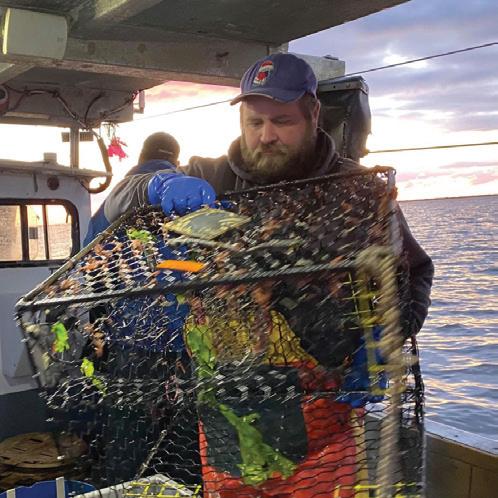
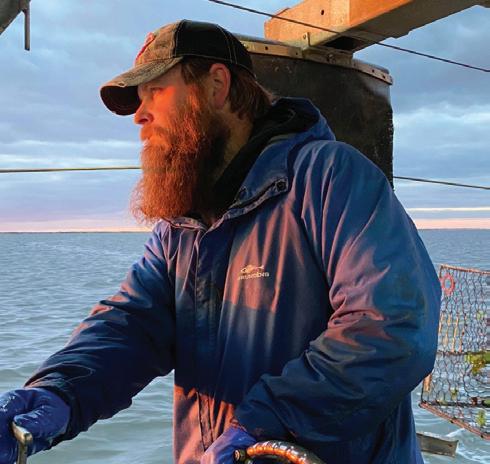
softshells.
“It’s staying in New Jersey for the most part. A lot of it is going to the cities,” he said. “We’re going to have to get creative after Memorial Day, because everything will happen.” Restaurant closings into the summer continued to hobble New Jersey fi shermen. Muermann, clam growers and tilefi sh longliners took to social media to crosspromote their products, and Muermann helped his in-laws’ Shady Rest seafood restaurant keep their expanded take-out business going. The brothers learned crabbing with their father, Bill Muermann, whose bushel crabs were a staple for summer residents in Ocean County beach resorts and bayside neighborhoods. In a family photo from 1983, Bill holds Jason on his shoulder by his truck alongside the road in Bayville, N.J.
“That’s where we started this business, with roadside stands,” Muermann said. “For a lot of people, it feels like we’re going back there.” — Kirk Moore
Atlantic
“It’s time for immediate action to protect these whales — NOAA should expand mandatory speed restriction zones and require ships to slow down when whales are present.” — Whitney Webber, Oceana
Vessel strikes blamed in fi rst 2020 right whale death
International conservation group moves species status to ‘critically endangered’

Right whale #3560 with her calf off the coast of Georgia in December 2019.
The fi rst reported North Atlantic right whale death in U.S. waters this year was a young male calf found dead off New Jersey June 27, likely the victim of two vessel strikes weeks apart.
It was bad news for the highly endangered species — now numbering only around 400 animals — that seemed to have some good luck with 10 young born during the 2019-20 calving season off Georgia and Florida.
Experts with the New England Aquarium and Florida Fish and Wildlife Conservation Commission identifi ed the dead whale as the male calf of a female right whale known as #3560, fi rst seen together of the coast of Georgia in mid-December 2019.
A Coast Guard boat crew towed the carcass to the nearby beach at Sandy Hook, N.J., for a necropsy. The exam documented evidence the calf had been struck by vessels at least twice.
Propeller wounds across the head and chest “were likely several weeks old, but were serious enough they may

Georgia DNR/CMARI have signifi cantly impaired the whale,” according to a summary released by NOAA offi cials. A second vessel collision left wounds across the tail stock “and were likely the cause of death.”
Vessel strikes and fi shing gear entanglements are major causes of accidental right whale deaths and injuries, with 31 animals dead and 10 seriously injured in Canadian and U.S. waters since 2017, according to NOAA.
The International Union for Conservation of Nature said July 9 that it is changing the status of the North Atlantic right whale from “endangered” to “critically endangered” on its Red List of Threatened Species, “recognizing that the species faces an extremely high risk of extinction.”
Some whale advocates say the federal government needs to take a harder line with mandatory speed limits when whales are sighted around shipping lanes and East Coast port approaches.
“Studies have found that slowing ship speeds to less than 10 knots in areas where these whales may be encountered can reduce the lethality of collisions by 86 percent,” said Whitney Webber, a campaign director with the environmental group Oceana.
The group issued a report in March that used vessel tracking data to fi nd apparently widespread disregard for NOAA’s voluntary speed limit advisories when whales were reported south of Nantucket in January to March of 2020.
The Oceana analysis calculated that 41 percent of 446 vessels tracked during that period exceeded the 10-knot limit for vessels 65 feet and larger.
“It’s time for immediate action to protect these whales — NOAA should expand mandatory speed restriction zones and require ships to slow down when whales are present,” said Webber. “The future of this species depends on what we do now, and this calf’s death should be a wakeup call that change needs to happen now.” — Kirk Moore
Coral amendment adjusts management of monument
New England council reclaims fi shing area
AJune 5 presidential proclamation ended a prohibition on commercial fi shing in the Northeast Canyons and Seamounts Marine National Monument and returned management of the area to the New England Fishery Management Council.
“We’ve said from the beginning that

fishery management councils are best suited to address the complicated tradeoffs involved in managing fisheries, and we appreciate regaining our control to do so in the monument area,” said Council Chairman John Quinn.
The nearly 5,000-square-mile Atlantic monument southeast of Cape Cod was established in 2016 by President Barack Obama. It was the first (and is currently the only) Atlantic monument. Before the designation, key areas were managed as essential fish habitat through the New England council.
On June 17, the council laid out its management of the area and announced the pending implementation of its Omnibus Deep-Sea Coral Amendment, which will expand fishing restrictions in the canyons area.
“To the best of our knowledge, zero fishing activity takes place on the seamounts,” said Janice Plante, public affairs officer for the council. “We’re not aware of any real groundfish fishing activity in the canyons portion of the monument area either.”
Tilefish, monkfish and squid fisheries are restricted around Oceanographer and Lydonia canyons. The coral amendment will restrict all fishing — except for deepsea red crab pots — between those canyons roughly 600 meters (about 330 fathoms) and deeper out to the 200-mile limit.
Some press coverage and public responses to the news indicated that the policy reversal would blow the area wide open to unregulated commercial fishing, leading to destruction of long-protected habitat.
“This is not true at all,” said Tom Nies, the council’s executive director. “The monument area will not be ‘wide open to industrial fishing.’”
All eight regional fishery management councils submitted a letter opposing commercial fishing bans in monument areas, stating that the designations work in opposition to sound fishery management practices, and “hinder the councils’ ability to sustainably manage fisheries throughout their range.” — Jessica Hathaway
Boat of the Month
Bully net boat Key Largo, Fla. / Spiny lobster
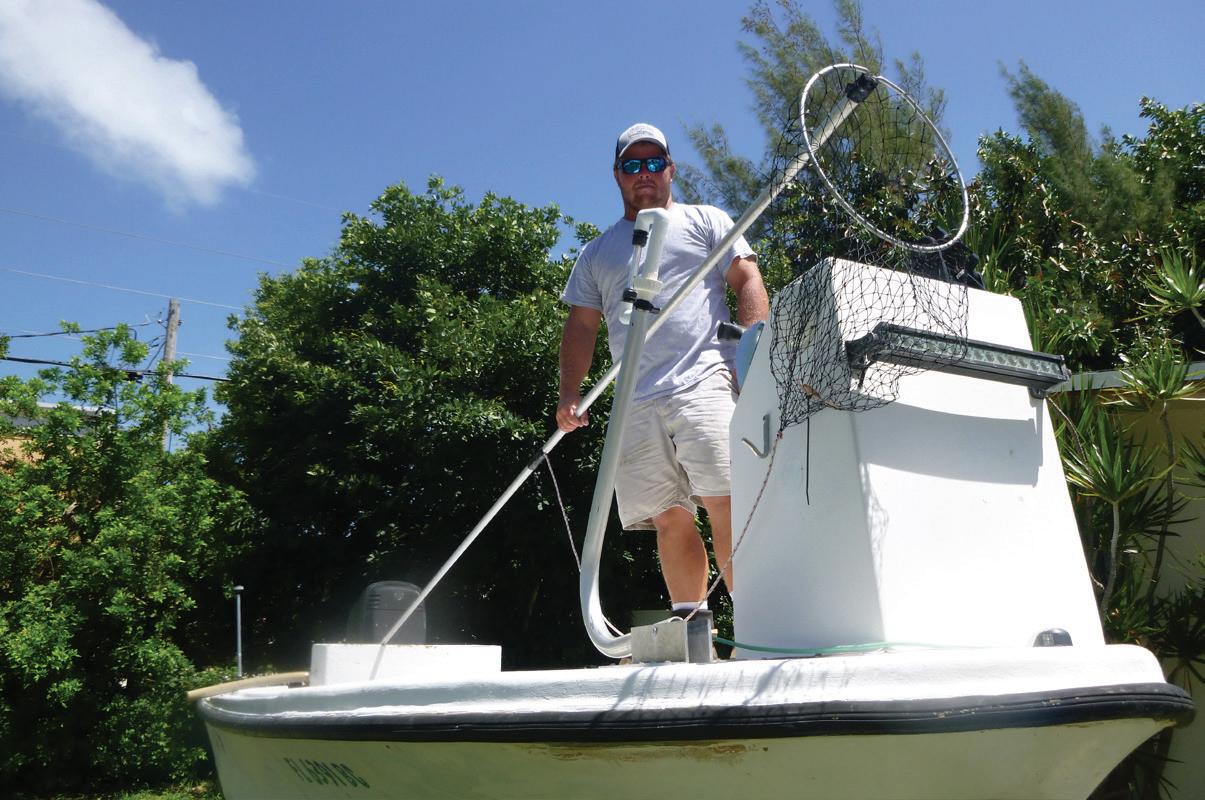
t age 26, Key Largo
Acommercial fisherman Ernie Piton III has become quite the boat rehabber; his sixth and latest re-creation is an aged, unnamed fiberglass skiff rebuilt for bully netting lobster in the shallows of the Florida Keys and Miami’s Biscayne Bay.
Almost every night during lobster season, which begins in August and runs through March, Piton can be found cruising slowly through flats and channels, standing at the helm on the reinforced bow of his unnamed 17-foot Mako skiff, looking for crustaceans crawling on the lit-up bottom.
With one hand on the throttle and the other clutching a 14-foot-long pole attached to a mesh net, Piton can see the creatures clearly within the radius of his twin, foldable 500-watt, 120- volt underwater lights encased in PVC piping.
He scoops one up in his net and drops it into a fiberglass hold in the stern that can hold 200 pounds of live lobster. Then he continues along, bumping his rebuilt 1997 Mercury 115-horsepower outboard in and out of gear and using lights powered by a 2,000-watt Honda Powerhorse gasoline generator.
On a decent night, he says he averages 100 pounds.
“I can fish every day and not put a ton of money into it and still be able to make good money,” Piton said of bully netting.
He also runs lobster traps but says the trap tags are too expensive to fish a large number. And he operates three other boats he rebuilt himself for the stone crab, live bait and yellowtail/ amberjack fisheries.
“I do it all,” Piton said. — Sue Cocking
Boat Specifications
HOME PORT: Key Largo, Fla. OWNER: Ernie Piton III BUILDER: Mako Boats YEAR BUILT: 1978 FISHERIES: Spiny lobster HULL: Fiberglass LENGTH: 17 feet BEAM: 7 feet DRAFT: 15 inches CREW: 1 MAIN PROPULSION: 115-hp Mercury twostroke outboard PROPELLER: Stainless steel three-blade SPEED: 25 knots FUEL CAPACITY: 30 gallons ELECTRONICS: Garmin Echomap Plus 64 CV chartplotter/ sounder
Gulf / South Atlantic
“As long as the dead zone persists, our way of life, and the rich seafood culture of the region, is in danger.” — John Williams, Southern Shrimp Alliance
Gulf dead zone damages tallied at $2.4 billion annually
Scientists predict summer 2020 zone will expand to cover 6,700 square miles
Mississippi basin river ows 30 percent above average will bring an expanded “dead zone” of hypoxia to the Gulf Coast but fall short of a record-setting 2017 blight, according to NOAA.
The agency’s scientists calculated the region of low- to no-oxygen water lethal to sh and marine life will expand to 6,700 square miles at its peak. That’s beyond the average annual measured size of 5,387 square miles, but far short of a recordsetting 8,776 square miles of sea — bigger than the land area of New Jersey — that


was charted in 2017.
Sine 1980, annual loads of nitrogen and phosphorus compounds washing out with the rain from farmland and urban centers throughout the vast Mississippi watershed have caused $2.4 billion annually in damages to Gulf of Mexico sh stocks and habitat, according to a Union of Concerned Scientists study issued days before NOAA’s forecast came out.
“Gulf Coast communities know that the dead zone impacts their livelihoods, but research has never put a dollar value

Cordova Bay, Alaska
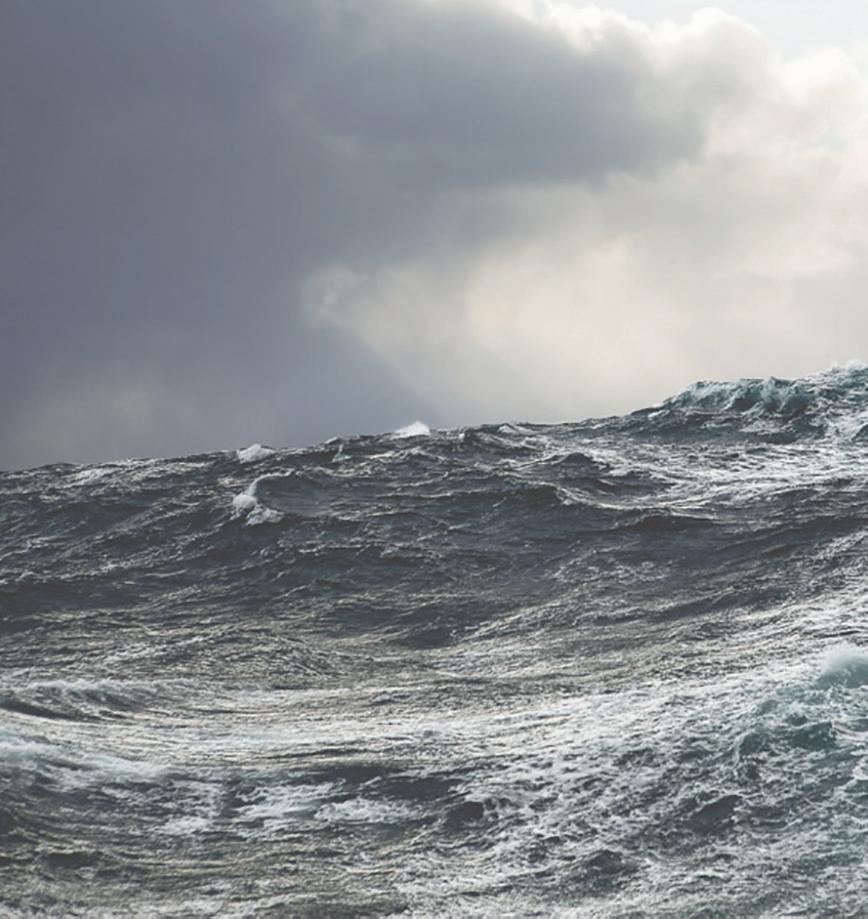
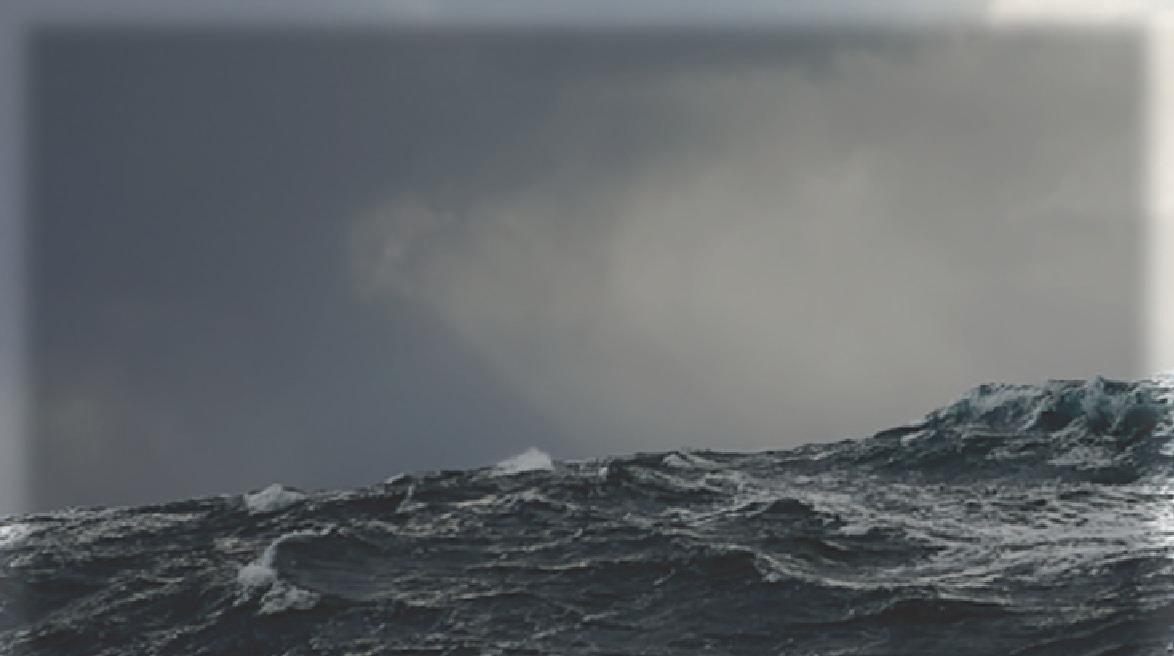

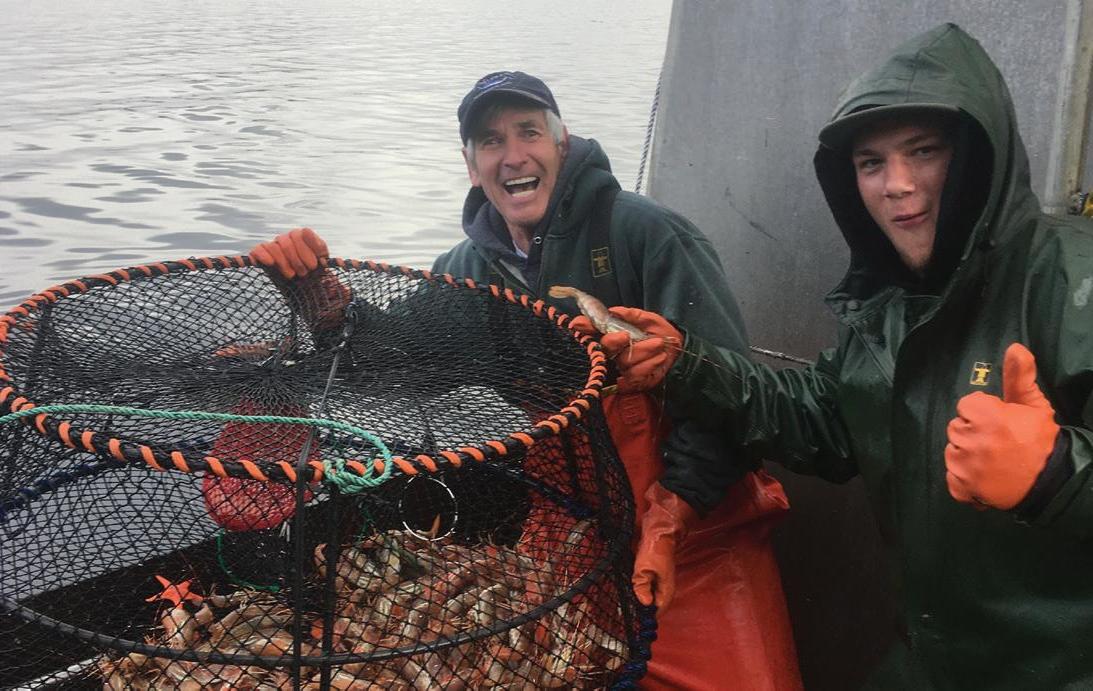


Bobby Newcomb and Austin Dixon pull prawn pots aboard the F/V William out of Craig, Alaska.
This is your life. Submit your Crew Shot nationalfi sherman.com/submit-crew-shots
The annual summer “dead zone” off the Gulf Coast reached a record-setting 8,776 square miles in 2017.


on its damage to the shing industry,” said Rebecca Boehm, an economist with the group who authored the report. “This study quanti es both the amount of nitrogen owing to the gulf from farms upstream, and the toll it is taking economically on the foundation of the gulf shing industry.”
“Lots of factors cause shrimpers to lose business, but covid-19 may completely shut many of us down,” said John Williams, a longtime shrimp captain and executive director of the Southern Shrimp Alliance.
“Hopefully the industry will get through this health crisis, and in the meantime, we need to address what we can to ensure the gulf’s long-term sustainability,” said Williams. “As long as the dead zone persists, our way of life, and the rich seafood culture of the region is in danger.”
The report recommends more nancial and technical support to help farmers change their operations, such as discounts on crop insurance for farmer who prioritize better soil management and expand existing conservation programs so more farmers can participate.
“Midwest farmers and gulf shers are in this together,” said Boehm. “Nitrogen pollution and unhealthy soil hurt the ecosystem upon which the gulf shing economy is based. With technical and nancial support, farmers can work the land to increase their own resilience, while also protecting the vital gulf shing culture and economy downstream.” — Kirk Moore
South Atlantic red snapper survives as a ‘mini-season’
42,510-fi sh limit after closure threat
Adecade after an ominous stock assessment posed the threat of a 35-year total shery closure, South Atlantic red snapper shing was back in July — sort of.
Recreational anglers ocked to Florida’s Atlantic coast for their four-day opening on the July 10-12 weekend and July 17. With a one- sh possession limit and catch target of 29,656, it’s typical of truncated seasons since 2010.
Back then, the South Atlantic Fishery Management Council and NMFS were looking at a crash course in reef sh protection that could have closed for many years the EEZ from McClellanville, S.C., to Melbourne, Fla. (see “Bottoming Out,” NF February 2010, page 22).
The South Atlantic stock is still classed as recovering and managed under rules established in 2018 by Amendment 43 to the
The commercial South Atlantic red snapper fi shery lingers with a 75-pound trip limit.


South Atlantic snapper-grouper shery. Today the vestigial commercial incidental shery that opened July 13 has a target catch of 124,815 pounds, with a trip limit of 75 pounds.
It’s a far cry from the Gulf of Mexico red snapper shery, split by joint federal and state management, and a 15 million-pound annual catch limit shared between recreational for-hire, private boat and commercial individual shing quota permit holders.
“Everybody wants to go catch red snapper,” captain Brian Godwin of Savage Pursuit Fishing Charters in Fort Pierce, Fla., told the Treasure Coast News as the charter eet was gearing up. “If we had a 45-day shing season like they do in the Gulf of Mexico, I’d have 45 trips booked.” — Kirk Moore
Maritime Fab Big Bay Roller Stern Roller Strength Like You’ve Never Seen Before!
16” dia. Core for increased net traction & reduced fish knock-outs Heavy-duty 3/8” formed aluminum side frames
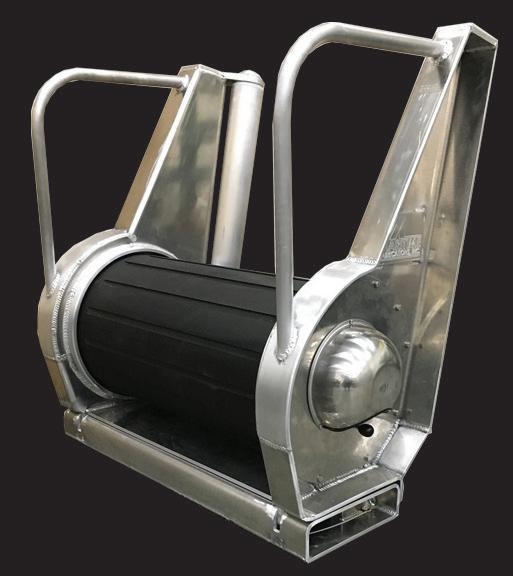
Integral ball valve for hubless freewheeling
Low profile base hinges with easily accessible locks
We take the heat, so you don’t have to.
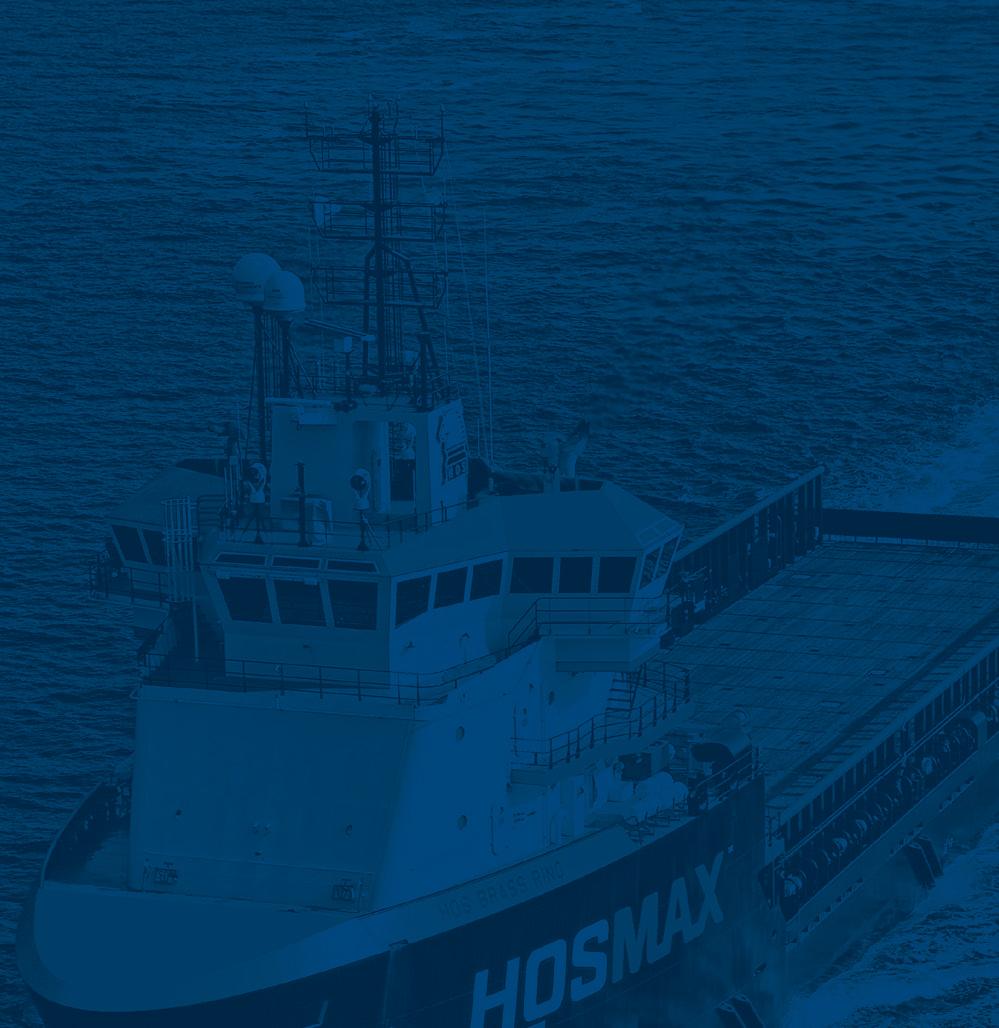
Cool. Because you need it. We deliver cool based on your reality. So no matter where you operate, hot days and heavy loads will never slow you down.
GRIDCOOLER® Keel Cooler
WEKA Boxcooler® Tranter® Heat Exchangers
La Conner, WA: (360) 466-3629 www.laconnermaritime.com
fernstrum.com | 1.906.863.5553 | sales@fernstrum.com ISO 9001:2015
